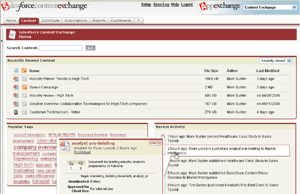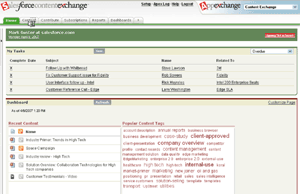 Salesforce released a new content management platform this evening, called Apex Content. It allows customers to build applications around unstructured “documents” such as office documents, HTML, audio/video and email files and then integrate those applications into other Salesforce applications.
Salesforce released a new content management platform this evening, called Apex Content. It allows customers to build applications around unstructured “documents” such as office documents, HTML, audio/video and email files and then integrate those applications into other Salesforce applications.
The technology behind Apex Content was originally developed by Koral Technologies, which Salesforce acquired in March 2007. As an aside, Salesforce has made a habit of acquiring companies that create Salesforce applications. Last year they bought Keiden Corporation, another company with an Appexchange application they liked.
 In a discussion I had today with Salesforce VP Product Management Woodson Martin, he stressed that they looked for best of breed features in many consumer web applications in building the platform. Many of these features shine in the first application on the platform, called ContentExchange, which lets users organize documents by tags and share them within the enterprise.
In a discussion I had today with Salesforce VP Product Management Woodson Martin, he stressed that they looked for best of breed features in many consumer web applications in building the platform. Many of these features shine in the first application on the platform, called ContentExchange, which lets users organize documents by tags and share them within the enterprise.
Documents can be uploaded, downloaded, and shared within project “workspaces”. Versioning support is built in, along with the ability to tag, rate, comment and get automated file recommendations based on the document’s meta data. User can also subscribe to documents via RSS (based on tag, author, etc.). Salesforce uses an example – a user in the legal department wants to know when any new documents are created on Sarbanes Oxley compliance, and can receive them automatically by subscribing.
 Each project workspace will support more structured workflow as well, allowing users to check documents in and out, create multiple versions, and define the required action steps in a document’s workflow (approval, task assignment, etc.). It is also integrated with Salesforce’s CRM application, allowing users to attach documents to the CRM records they already have.
Each project workspace will support more structured workflow as well, allowing users to check documents in and out, create multiple versions, and define the required action steps in a document’s workflow (approval, task assignment, etc.). It is also integrated with Salesforce’s CRM application, allowing users to attach documents to the CRM records they already have.
The application’s AJAX interface is relatively plain, consisting tabs for managing your requested workflow tasks, searching files, contributing content, managing subscriptions, running reports, and viewing dashboards. The content tab, where you manage search files, consists of a simple file list, tag cloud, and recent activity. The file list can be sorted by name, type, your subscriptions, file size, author, and modification date, or selected by tag from the tag cloud. The general search functions searches all text included in any uploaded document as well as the metadata. Mousing over a file gives a preview of its meta data (title, rating, tags, description, etc.). They’re also building out a file preview system, which currently only pops up a Flash preview of PowerPoint slide shows.
ContentExchange is a hosted, stand-alone enterprise content management system (ECM). This puts them firmly in competition with Microsoft’s Sharepoint, ECM’s Documentum, Hummingbird, IBM, FileNet, Corel Lightning, and Oracle, which acquired Stellant last November for $440 million. However, Saleforce’s simple approach to document management by tags is relatively unique in an industry filled with dense whitepapers on “Unified Enterprise Content Management” systems. Pricing is yet to be announced.